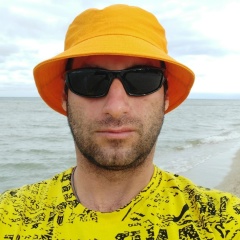#годовщинааварии
..не знал, что АЭС в Чернобыле работала еще 15 лет после аварии..
..25 апреля 1986 года на ЧАЭС должно было пройти проектное испытание системы обеспечения безопасности на 4-м энергоблоке.
После этого реактор должны были остановить, чтобы провести плановые ремонтные работы. Во время испытаний оборудование АЭС предполагалось обесточить и использовать механическую энергию вращения останавливающихся турбогенераторов, чтобы обеспечить работоспособность систем безопасности энергоблока.
Остановка реактора была не единожды отложена, что стало причиной определенных трудностей с управлением мощностью реактора.
26 апреля в 01 час 24 минуты зафиксирован неконтролируемый рост мощности, вызвавший взрывы и разрушения значительной части установки реактора.
Здание энергоблока, кровля машинного зала частично обрушились. В различных помещениях и на крыше возникло более 30 очагов пожара. Основные очаги пожара на крыше машинного зала к 2 часам 10 минутам и на крыше реакторного отделения к 2 часам 30 минутам были подавлены. К 5 часам 26 апреля пожар был ликвидирован.
В 20 часов 26 апреля в разных частях центрального зала 4 блока возник пожар большой интенсивности. К тушению данного пожара вследствие тяжелой радиационной обстановки и значительной мощности горения штатными средствами не приступали.
Для ликвидации возгорания и обеспечения подкритичности дезорганизованного топлива использовалась вертолётная техника.
В первые часы развития аварии остановлен соседний 3-й энергоблок, произведены отключения оборудования 4-го энергоблока, разведка состояния аварийного реактора.
По факту аварии для выяснения её причин и ликвидации последствий была создана Правительственная комиссия, которая вечером 26 апреля прибыла в район аварии, и возглавила в зоне ЧАЭС всю сложную организационную структуру, оперативные группировки сил и средств министерств и ведомств, участвовавших в ликвидации последствий аварии.
27 апреля в связи с высоким уровнем радиации были эвакуированы 49 тысяч жителей близлежащего города Припять, а позже и население из 30-километровой циркульной зоны вокруг Чернобыльской АЭС.
16 мая правительственной комиссией было принято решение о долговременной консервации 4-го энергоблока.
В результате аварии вокруг АЭС создана 30-километровая зона отчуждения, уничтожены и захоронены (закопаны тяжелой техникой) сотни мелких населённых пунктов.
Как вспоминают ликвидаторы, радиация сильно повлияла на всё живое в зоне отчуждения. Изменилась природа, поведение птиц и животных. После взрыва очень быстро стала расти трава, была очень высокой. Ягоды на рябине были величиной с приличную вишню, а обычные мухи к осени выросли до размеров шмеля. Птиц не стало ни в Припяти, ни в лесах. Собаки и кошки, оставленные своими хозяевами без присмотра, долго без пищи находиться не могли, поэтому при появлении человека старались подойти поближе, шерсть у них выпадала клочьями.
Когда начала поспевать клубника, ягоды достигали до 100 грамм веса. Ничего из произрастающих растений принимать в пищу было нельзя. Коров доили, но молоко в пищу не употребляли – выливали на землю. Как вспоминает Г. Колюбаева: «Ловили щук, их проверяли дозиметристы. Голова «звенит», а туловище нет. Вот мы отрезали головы и ели такую рыбу».
Наиболее сильно пострадали северные районы Киевской и Житомирской областей Украины, Гомельская область Белоруссии и Брянская область России. Радиация задела даже некоторые значительно удалённые от места аварии регионы, например Ленинградскую область, Мордовию и Чувашию — там выпали радиоактивные осадки.
По данным Всемирной организации здравоохранения, в результате аварии на ЧАЭС погибло около 9 тыс. человек.
15 декабря 2000 года в 13:17 по приказу Президента Украины поворотом ключа аварийной защиты (АЗ-5) навсегда остановлен реактор энергоблока № 3 Чернобыльской АЭС. Станция прекратила генерацию электроэнергии.
В конце ноября 2016 года, над четвертым энергоблоком ЧАЭС был установлен новый саркофаг (https://vk.com/energo_public?w=wall-5...). Новая арка (новый безопасный конфайнмент, НБК) над старым саркофагом (объектом «Укрытие»), накрывшем разрушенный в 1986 году четвертый энергоблок Чернобыльской атомной электростанции.
На данный момент Чернобыльская АЭС перешла к этапу снятия с эксплуатации (http://vk.com/energo_public?w=wall-52335707...). На этапе окончательного закрытия и консервации энергоблоков Чернобыльской АЭС, который будет продолжаться до 2028 года, деятельность в основном будет касаться реакторов, контуров многократной принудительной циркуляции и смежного оборудования блоков 1,2 и 3 Чернобыльской АЭС.
Затем, после длительной выдержки реакторных установок, радиоактивное излучение снизится естественным образом, и к 2065 году начнется демонтаж оборудования.
Аварию на Чернобыльской АЭС оценивают как крупнейшую в своем роде за всю историю атомной энергетики, по количеству погибших и пострадавших, и по экономическому ущербу.
#чернобыль #годовщина #авария #аэс #радиация #припять
..не знал, что АЭС в Чернобыле работала еще 15 лет после аварии..
..25 апреля 1986 года на ЧАЭС должно было пройти проектное испытание системы обеспечения безопасности на 4-м энергоблоке.
После этого реактор должны были остановить, чтобы провести плановые ремонтные работы. Во время испытаний оборудование АЭС предполагалось обесточить и использовать механическую энергию вращения останавливающихся турбогенераторов, чтобы обеспечить работоспособность систем безопасности энергоблока.
Остановка реактора была не единожды отложена, что стало причиной определенных трудностей с управлением мощностью реактора.
26 апреля в 01 час 24 минуты зафиксирован неконтролируемый рост мощности, вызвавший взрывы и разрушения значительной части установки реактора.
Здание энергоблока, кровля машинного зала частично обрушились. В различных помещениях и на крыше возникло более 30 очагов пожара. Основные очаги пожара на крыше машинного зала к 2 часам 10 минутам и на крыше реакторного отделения к 2 часам 30 минутам были подавлены. К 5 часам 26 апреля пожар был ликвидирован.
В 20 часов 26 апреля в разных частях центрального зала 4 блока возник пожар большой интенсивности. К тушению данного пожара вследствие тяжелой радиационной обстановки и значительной мощности горения штатными средствами не приступали.
Для ликвидации возгорания и обеспечения подкритичности дезорганизованного топлива использовалась вертолётная техника.
В первые часы развития аварии остановлен соседний 3-й энергоблок, произведены отключения оборудования 4-го энергоблока, разведка состояния аварийного реактора.
По факту аварии для выяснения её причин и ликвидации последствий была создана Правительственная комиссия, которая вечером 26 апреля прибыла в район аварии, и возглавила в зоне ЧАЭС всю сложную организационную структуру, оперативные группировки сил и средств министерств и ведомств, участвовавших в ликвидации последствий аварии.
27 апреля в связи с высоким уровнем радиации были эвакуированы 49 тысяч жителей близлежащего города Припять, а позже и население из 30-километровой циркульной зоны вокруг Чернобыльской АЭС.
16 мая правительственной комиссией было принято решение о долговременной консервации 4-го энергоблока.
В результате аварии вокруг АЭС создана 30-километровая зона отчуждения, уничтожены и захоронены (закопаны тяжелой техникой) сотни мелких населённых пунктов.
Как вспоминают ликвидаторы, радиация сильно повлияла на всё живое в зоне отчуждения. Изменилась природа, поведение птиц и животных. После взрыва очень быстро стала расти трава, была очень высокой. Ягоды на рябине были величиной с приличную вишню, а обычные мухи к осени выросли до размеров шмеля. Птиц не стало ни в Припяти, ни в лесах. Собаки и кошки, оставленные своими хозяевами без присмотра, долго без пищи находиться не могли, поэтому при появлении человека старались подойти поближе, шерсть у них выпадала клочьями.
Когда начала поспевать клубника, ягоды достигали до 100 грамм веса. Ничего из произрастающих растений принимать в пищу было нельзя. Коров доили, но молоко в пищу не употребляли – выливали на землю. Как вспоминает Г. Колюбаева: «Ловили щук, их проверяли дозиметристы. Голова «звенит», а туловище нет. Вот мы отрезали головы и ели такую рыбу».
Наиболее сильно пострадали северные районы Киевской и Житомирской областей Украины, Гомельская область Белоруссии и Брянская область России. Радиация задела даже некоторые значительно удалённые от места аварии регионы, например Ленинградскую область, Мордовию и Чувашию — там выпали радиоактивные осадки.
По данным Всемирной организации здравоохранения, в результате аварии на ЧАЭС погибло около 9 тыс. человек.
15 декабря 2000 года в 13:17 по приказу Президента Украины поворотом ключа аварийной защиты (АЗ-5) навсегда остановлен реактор энергоблока № 3 Чернобыльской АЭС. Станция прекратила генерацию электроэнергии.
В конце ноября 2016 года, над четвертым энергоблоком ЧАЭС был установлен новый саркофаг (https://vk.com/energo_public?w=wall-5...). Новая арка (новый безопасный конфайнмент, НБК) над старым саркофагом (объектом «Укрытие»), накрывшем разрушенный в 1986 году четвертый энергоблок Чернобыльской атомной электростанции.
На данный момент Чернобыльская АЭС перешла к этапу снятия с эксплуатации (http://vk.com/energo_public?w=wall-52335707...). На этапе окончательного закрытия и консервации энергоблоков Чернобыльской АЭС, который будет продолжаться до 2028 года, деятельность в основном будет касаться реакторов, контуров многократной принудительной циркуляции и смежного оборудования блоков 1,2 и 3 Чернобыльской АЭС.
Затем, после длительной выдержки реакторных установок, радиоактивное излучение снизится естественным образом, и к 2065 году начнется демонтаж оборудования.
Аварию на Чернобыльской АЭС оценивают как крупнейшую в своем роде за всю историю атомной энергетики, по количеству погибших и пострадавших, и по экономическому ущербу.
#чернобыль #годовщина #авария #аэс #радиация #припять
#Anniversary of the accident
..did not know that the Chernobyl nuclear power plant was operating for another 15 years after the accident ..
..On April 25, 1986, the Chernobyl NPP was to undergo a design test of the safety system at the 4th power unit.
After that, the reactor had to be stopped in order to carry out scheduled repairs. During the tests, the NPP equipment was supposed to de-energize and use the mechanical rotational energy of the stopped turbine generators to ensure the operability of the power unit's safety systems.
The shutdown of the reactor was delayed more than once, which caused certain difficulties in controlling the power of the reactor.
On April 26, at 01 hours and 24 minutes, an uncontrolled increase in power was recorded, which caused explosions and destruction of a significant part of the reactor installation.
The building of the power unit, the roof of the engine room partially collapsed. In various rooms and on the roof there were more than 30 fires. The main fires on the roof of the turbine hall at 2 hours and 10 minutes and on the roof of the reactor compartment at 2 hours and 30 minutes were suppressed. By 5 hours on April 26, the fire was extinguished.
At 20 hours on April 26, a fire of high intensity arose in different parts of the central hall of block 4. They did not proceed with standard means to extinguish this fire due to severe radiation conditions and significant burning power.
To eliminate the fire and ensure the subcriticality of the disorganized fuel, helicopter equipment was used.
In the first hours of the development of the accident, the neighboring 3rd power unit was stopped, equipment of the 4th power unit was shut down, and the status of the emergency reactor was reconnoitered.
Upon the fact of the accident, a Government Commission was established to find out its causes and eliminate the consequences, which arrived in the accident area on the evening of April 26 and headed the entire complex organizational structure, operational groups of forces and means of the ministries and departments involved in the aftermath of the accident in the Chernobyl zone.
On April 27, due to the high level of radiation, 49 thousand residents of the nearby city of Pripyat were evacuated, and later the population from the 30-km circular zone around the Chernobyl nuclear power plant.
On May 16, the government commission decided on the long-term conservation of the 4th power unit.
As a result of the accident, a 30-kilometer exclusion zone was created around the nuclear power plant, hundreds of small settlements were destroyed and buried (buried with heavy equipment).
As the liquidators recall, radiation greatly affected everything living in the exclusion zone. The nature, behavior of birds and animals has changed. After the explosion, the grass began to grow very quickly, it was very high. The berries on the mountain ash were the size of a decent cherry, and ordinary flies by the fall grew to the size of a bumblebee. There were no birds in Pripyat or in the forests. Dogs and cats left unattended by their owners could not be without food for a long time, so when a person appeared, they tried to come closer, their hair fell out in shreds.
When the strawberries began to ripen, the berries reached 100 grams of weight. None of the growing plants could be taken as food. Cows were milked, but milk was not consumed - they were poured onto the ground. As G. Kolyubaeva recalls: “Caught pikes, they were checked by dosimetrists. The head “rings”, but the body does not. So we cut off our heads and ate such a fish. ”
The northern regions of the Kiev and Zhytomyr regions of Ukraine, the Gomel region of Belarus, and the Bryansk region of Russia suffered the most. Radiation affected even some regions far removed from the accident site, for example, the Leningrad Region, Mordovia and Chuvashia - there were radioactive fallout.
According to the World Health Organization, about 9 thousand people died as a result of the Chernobyl accident.
On December 15, 2000 at 13:17, by order of the President of Ukraine, turning the emergency protection key (AZ-5) permanently stopped the reactor of Unit 3 of the Chernobyl nuclear power plant. The station stopped generating electricity.
At the end of November 2016, a new sarcophagus was installed above the fourth Chernobyl power unit (https: //vk.com/energo_public? W = wall-5 ...). A new arch (a new safe confinement, NSC) above the old sarcophagus (Shelter object), which covered the fourth power unit of the Chernobyl nuclear power plant destroyed in 1986.
At the moment, the Chernobyl NPP has moved to the phase of decommissioning (http: //vk.com/energo_public? W = wall-52335707 ...). At the stage of the final closure and conservation of the Chernobyl nuclear power units, which will continue until 2028, the activities will mainly concern reactors, multiple forced circulation circuits and related equipment of Chernobyl NPP units 1,2 and 3.
Then, after a long exposure of the reactor plants, the radioactive radiation will naturally decrease, and by 2065 the dismantling of the equipment will begin.
The accident at the Chernobyl nuclear power plant is estimated as the largest of its kind in the entire history of nuclear energy, by the number of dead and injured, and by economic damage.
# Chernobyl # anniversary # accident # nuclear power # radiation # Pripyat
..did not know that the Chernobyl nuclear power plant was operating for another 15 years after the accident ..
..On April 25, 1986, the Chernobyl NPP was to undergo a design test of the safety system at the 4th power unit.
After that, the reactor had to be stopped in order to carry out scheduled repairs. During the tests, the NPP equipment was supposed to de-energize and use the mechanical rotational energy of the stopped turbine generators to ensure the operability of the power unit's safety systems.
The shutdown of the reactor was delayed more than once, which caused certain difficulties in controlling the power of the reactor.
On April 26, at 01 hours and 24 minutes, an uncontrolled increase in power was recorded, which caused explosions and destruction of a significant part of the reactor installation.
The building of the power unit, the roof of the engine room partially collapsed. In various rooms and on the roof there were more than 30 fires. The main fires on the roof of the turbine hall at 2 hours and 10 minutes and on the roof of the reactor compartment at 2 hours and 30 minutes were suppressed. By 5 hours on April 26, the fire was extinguished.
At 20 hours on April 26, a fire of high intensity arose in different parts of the central hall of block 4. They did not proceed with standard means to extinguish this fire due to severe radiation conditions and significant burning power.
To eliminate the fire and ensure the subcriticality of the disorganized fuel, helicopter equipment was used.
In the first hours of the development of the accident, the neighboring 3rd power unit was stopped, equipment of the 4th power unit was shut down, and the status of the emergency reactor was reconnoitered.
Upon the fact of the accident, a Government Commission was established to find out its causes and eliminate the consequences, which arrived in the accident area on the evening of April 26 and headed the entire complex organizational structure, operational groups of forces and means of the ministries and departments involved in the aftermath of the accident in the Chernobyl zone.
On April 27, due to the high level of radiation, 49 thousand residents of the nearby city of Pripyat were evacuated, and later the population from the 30-km circular zone around the Chernobyl nuclear power plant.
On May 16, the government commission decided on the long-term conservation of the 4th power unit.
As a result of the accident, a 30-kilometer exclusion zone was created around the nuclear power plant, hundreds of small settlements were destroyed and buried (buried with heavy equipment).
As the liquidators recall, radiation greatly affected everything living in the exclusion zone. The nature, behavior of birds and animals has changed. After the explosion, the grass began to grow very quickly, it was very high. The berries on the mountain ash were the size of a decent cherry, and ordinary flies by the fall grew to the size of a bumblebee. There were no birds in Pripyat or in the forests. Dogs and cats left unattended by their owners could not be without food for a long time, so when a person appeared, they tried to come closer, their hair fell out in shreds.
When the strawberries began to ripen, the berries reached 100 grams of weight. None of the growing plants could be taken as food. Cows were milked, but milk was not consumed - they were poured onto the ground. As G. Kolyubaeva recalls: “Caught pikes, they were checked by dosimetrists. The head “rings”, but the body does not. So we cut off our heads and ate such a fish. ”
The northern regions of the Kiev and Zhytomyr regions of Ukraine, the Gomel region of Belarus, and the Bryansk region of Russia suffered the most. Radiation affected even some regions far removed from the accident site, for example, the Leningrad Region, Mordovia and Chuvashia - there were radioactive fallout.
According to the World Health Organization, about 9 thousand people died as a result of the Chernobyl accident.
On December 15, 2000 at 13:17, by order of the President of Ukraine, turning the emergency protection key (AZ-5) permanently stopped the reactor of Unit 3 of the Chernobyl nuclear power plant. The station stopped generating electricity.
At the end of November 2016, a new sarcophagus was installed above the fourth Chernobyl power unit (https: //vk.com/energo_public? W = wall-5 ...). A new arch (a new safe confinement, NSC) above the old sarcophagus (Shelter object), which covered the fourth power unit of the Chernobyl nuclear power plant destroyed in 1986.
At the moment, the Chernobyl NPP has moved to the phase of decommissioning (http: //vk.com/energo_public? W = wall-52335707 ...). At the stage of the final closure and conservation of the Chernobyl nuclear power units, which will continue until 2028, the activities will mainly concern reactors, multiple forced circulation circuits and related equipment of Chernobyl NPP units 1,2 and 3.
Then, after a long exposure of the reactor plants, the radioactive radiation will naturally decrease, and by 2065 the dismantling of the equipment will begin.
The accident at the Chernobyl nuclear power plant is estimated as the largest of its kind in the entire history of nuclear energy, by the number of dead and injured, and by economic damage.
# Chernobyl # anniversary # accident # nuclear power # radiation # Pripyat

У записи 6 лайков,
0 репостов,
505 просмотров.
0 репостов,
505 просмотров.
Эту запись оставил(а) на своей стене Сергей Чумаченко


























